Industry evolves from integrated company programs
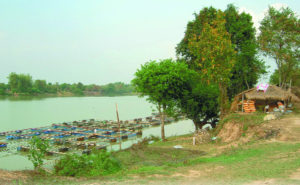
Introduced in Thailand in the 1960s, Nile tilapia (Oreochromis niloticus) have become the main farmed species in the country’s inland aquaculture. In 2001, recorded tilapia production was 84,500 metric tons (MT), with a value of 2.3 million baht (about U.S. $56,000), representing 32 percent of the country’s freshwater farming production.
The production is forecasted to reach 118,000 MT in 2005. The main farming system is freshwater ponds with various levels of intensification, although tilapia are also produced in paddy fields, ditches, and cages.
New development
While cage culture already existed on a small scale in some regions of northern Thailand, a new development took place within the last decade, thanks to the efforts of public and private research and extension services. In 1996, the large agri-business company Charoen Pokphand (C.P.) created a new Tabtim (Thai for “ruby”) strain of red tilapia for growing in cage systems by crossing black, Taiwan red, and Florida red strains.
An intensive system for cage farming red tilapia has been developed through joint trials with the Thai Department of Fisheries (DOF) based on high-density stocking of pregrown all-male fry fed pelleted food. This technique enables the production of large 600-gram to 1.5-kg fish in rivers or lakes in a relatively short production cycle. For example, a 600-gram black tilapia can be grown in three months following two months of nursing, compared with a total production time of 7 to 8 months in ponds.
This system has been disseminated widely throughout northern and central Thailand, mainly through contract proposals in which C.P. supplies seed and feed, and buys back the harvested fish at fixed prices. This system of vertical integration was later repeated by another company, Grobest. Some training has been provided by C.P. and Grobest technicians, as well as DOF extension services, which also contributed to development through its numerous hatcheries.
Simple and profitable
The cage farming is largely promoted as standardized, simple, and highly profitable. Taking into account only operating costs for seed and feed, a cage representing an investment of about U.S. $250, one crop would need 1,600 fry at $.06 and about 56 feed bags at $9.72. This system would produce a harvest of 800 kg to 1 MT and generate a turnover of $768.00 to $972.00, easily covering the cost of inputs and returning half of the capital investment within one crop.
The red tilapia fetch premium prices, and the large-size products enable filleting and export as frozen products. Particularly when compared to products from pond culture, the tilapia are free of off-flavors.
Impacts surveyed
Research by the authors in early 2004 examined the impacts of the new system in terms of technical and economic developments. Their survey in seven provinces of north, northeast, and central Thailand involved inquiries at 12 farms, 17 case studies, and interviews with the main players in the supply chain, including seed and food suppliers, extension technicians, middle men dealing the fish and distributors. Some findings were surprising.
Varied backing, infrastructure
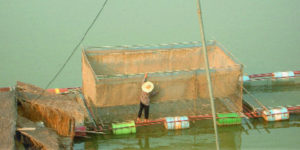
At farms working with 8 to 28 cages, installed mainly on the large Mekong, Mun and Chao Phraya Rivers, the background of the farmers was diversified – from agriculture farmers and public servants to shop keepers, house builders, and professors. Aquaculture was a secondary activity for many, but some farmers had abandoned rice or pig production activities after entering cage fish farming because of the latter’s better profitability and acceptable workload.
The main quoted constraint to enter cage farming was not technical, but the level of investment (U.S $65 to 250 per cage). Banks were reluctant to finance loans for the new type of production. Some farmers and farmer groups invested their own funds or accessed public support through the DOF. One group accessed a zero-interest community fund in its village.
While the infrastructure of cages was based on a similar pattern – a metallic or wooden raft with double or triple net supported by a rigid metallic frame – individual cage sizes ranged 13 to 62 cubic meters. Fry size at stocking varied 25 to 50 grams, while stocking density ranged 29 to 97 seeds per cubic meter. Final harvest densities were reported at 14 to 108 kilograms per cubic meter, with feed-conversion ratios of 1.0 to 1.7 for fish of 600 to 800 grams and 1.1 to 1.8 for fish of 900 to 1,200 grams.
The duration of growth (90 to 120 days for 600- to 800-gram fish, 120 to 150 days for 900- to 1,000-gram fish) and 80 to 90 percent survival rates were quite homogeneous. However, some farmers mentioned mortalities at the beginning of the rainy season or in the summer, and sometimes on a round-year basis, linked with water pollution or deficits, disease, or excess fish biomass.
Economic results
The computation of economic results for the surveyed farms showed wide variations for costs and margins. Operating costs varied U.S.$0.72 to $0.98 per kilogram of produced fish. Feed made up 80 to 94 percent of the cost, which explains why half of the farmers used hybrid catfish feed rather than more-expensive tilapia feed.
Variations of these costs and exfarm prices of U.S. $.92 to 1.15 per kilogram for black tilapia and $1.00 to 1.15 per kilogram for red tilapia resulted in gross margins ranging $.06 to $.50 per kilogram of produced fish. The fixed costs (amortization of investments, maintenance, and manpower) were calculated for a whole year and as a ratio to the total yearly harvest at 2 to 2.5 crops per cage. The estimated net margin of produced fish ranged $.02 to $.46 per kilogram.
Annual yields ranged 27 to 215 kilograms per cubic meter. Annual net profits varied U.S. $2.92 to 61.13 per cubic meter.
Supply chain organization
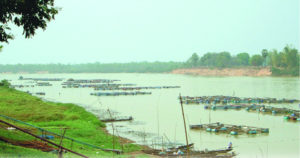
Some surprising features were observed regarding the organization of the supply chain. While all the farmers who began cage farming between 1999 and 2001 initially worked in an integrated organization with aqua-feed companies like C.P. or Grobest, a large number quit after two or three years.
Integrated organization was perceived as bringing too many constraints, notably at the beginning of each cycle with the paying of a deposit equivalent to the cost of half of the feed per crop. Farmers also reported little bargaining of exfarm prices and a general lack of freedom.
Aside from microintegrated networks organized by local middlemen, independent systems have been organized by individuals or groups for buying seed and feed, and selling through new outlets that include direct local sales in markets or to retailers, processing into value-added products, and sales to producer-owned restaurants.
Product differentiation
It could be expected that cage-raised tilapia, differentiated from pond tilapia, would supply special segments of the market. In local markets in the cage production areas, live black tilapia from cages did command higher prices than black tilapia from ponds. Two important supermarkets chains in Bangkok, however, bought black tilapia only from ponds due to the U.S. $.25 price differential for cage-reared fish at the wholesale level.
Red tilapia generally achieved a higher price (U.S. $1.76 per kilogram for a 600-gram fish) than black tilapia ($1.50 to $1.59 per kilogram for 600-gram fish).
Exports
According to foreign trade statistics, Thailand exported a relatively modest 4,300 MT of tilapia in 2002. This figure included primarily whole frozen black tilapia exported to Saudi Arabia and 700 MT of fillets and red tilapia sold as whole fresh or chilled product to Singapore.
While tilapia raised in cages are large enough for processing and export as frozen fillets, interviews with the biggest processing and exporting companies showed the main source of tilapia for the market was 900- to 1,200-gram black tilapia intensively farmed in brackish water near processing plants on the central plain of Thailand. Tilapia produced in cages came from further afield and sometimes had off-flavors. Considering the 2002 import prices in the United States, Thai products showed competitive prices, but exporters cited strong competition from other Asian exporters, namely China. On the other hand, Thailand exports to Laos, and other neighboring countries are under study.
Official statistics
The last available national statistics (DOF, 2001) indicated an overall production of 1,597 MT in 2,427 cages, compared to 83,000 MT from ponds. However, 2003 statistics established at the provincial level showed significant increases between 2001 and 2003: 368 to 1,917 cages in Mukdahan Province and 287 to around 2,000 cages in Ubon Ratchathani Province.
Moreover, representatives of the biggest companies in the sector mentioned a current total of over 10,000 cages and cage production of 30,000 MT. While it is difficult to verify this, it appears likely the recent boom in cage culture has led to underestimated national production data.
Future focus
While the limited number of interviews of this survey prohibit broad generalizations of the results, they do draw attention to two main points for the future. One is the need for research and training to improve the management of the farms, ensure profitability, and study relations with the environment.
Secondly, questions remain over whether domestic markets can be extended and the feasibility of opening up export markets. An in-depth market study will be necessary to more comprehensively analyze market opportunities.
(Editor’s Note: This article was originally published in the December 2004 print edition of the Global Aquaculture Advocate.)
Now that you've reached the end of the article ...
… please consider supporting GSA’s mission to advance responsible seafood practices through education, advocacy and third-party assurances. The Advocate aims to document the evolution of responsible seafood practices and share the expansive knowledge of our vast network of contributors.
By becoming a Global Seafood Alliance member, you’re ensuring that all of the pre-competitive work we do through member benefits, resources and events can continue. Individual membership costs just $50 a year.
Not a GSA member? Join us.
Authors
-
Prof. Catherine Mariojouls
Institut National Agronomique Paris-Grignon
16 Rue Claude Bernard – F
75231 Paris Cedex 05[114,102,46,103,112,97,110,105,64,117,111,106,111,105,114,97,109]
-
Malasri Khumsri
Fisheries Biologist
Amnatcharoen Inland Fisheries Station
Muang District
Amnatcharoen Province, Thailand -
Dr. Wanchai Worawattanamateekul
University of Kasetsart
Faculty of Fisheries
Bangkok, Thailand
Tagged With
Related Posts

Health & Welfare
10 paths to low productivity and profitability with tilapia in sub-Saharan Africa
Tilapia culture in sub-Saharan Africa suffers from low productivity and profitability. A comprehensive management approach is needed to address the root causes.
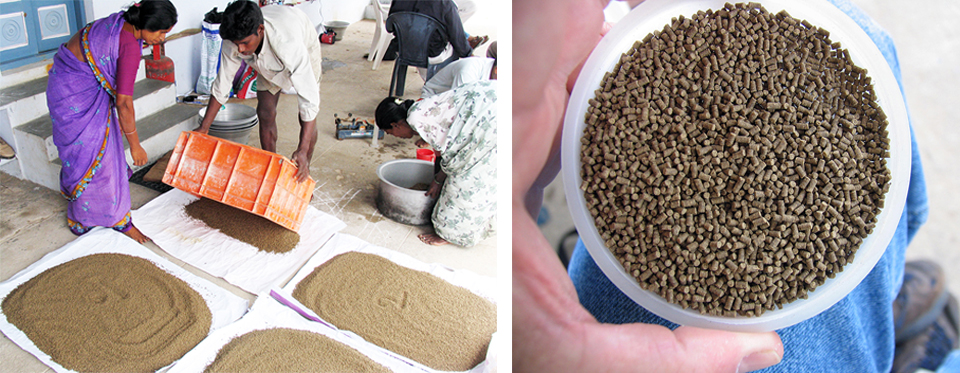
Aquafeeds
A look at India’s fish feed industry
India's fish-farming industry makes limited use of modern feeds, providing potential for the feed sector to grow. Commercial feeds are predominantly used for pangasius farming, followed by a rising popularity in carp culture.
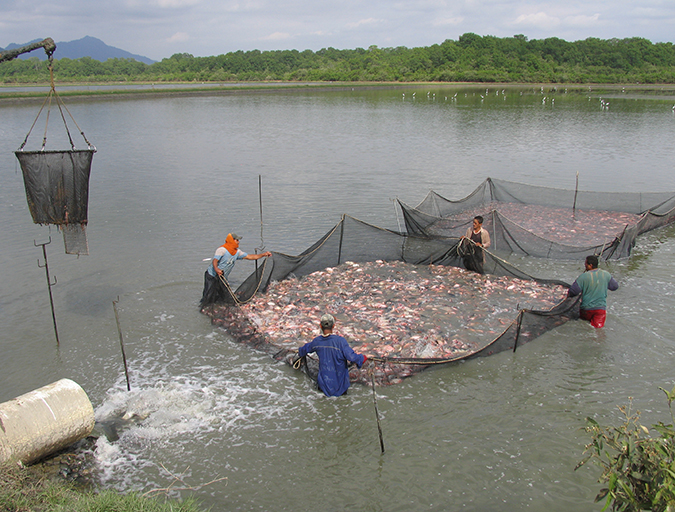
Responsibility
Addressing safety in Latin America’s tilapia supply chain
Over the last decade, the experience gained by many tilapia farmers combined with proficient programs implemented by local governments have significantly improved tilapia production in various Latin American countries like Colombia, Mexico, Ecuador and other important tilapia producers in the region.
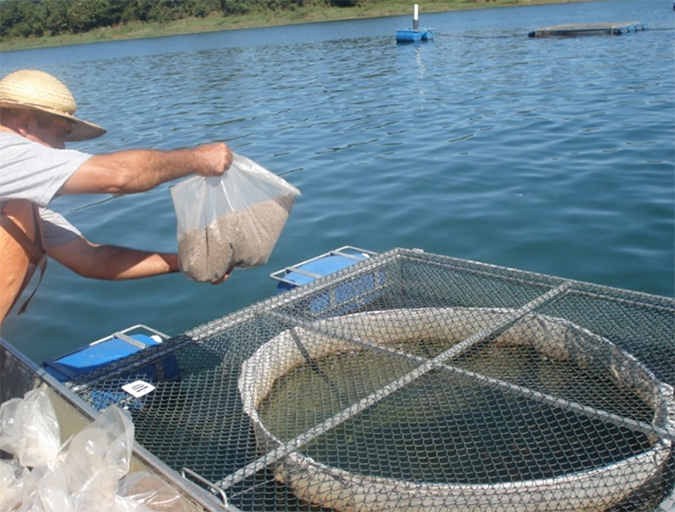
Health & Welfare
Aiding gut health with a natural growth promotor
A study with Nile tilapia conducted in commercial production cages in Brazil showed the potential – in the absence of major disease threats – of a commercial, natural growth promotor that modulates the microbiota (inhibiting growth of pathogenic bacteria and promoting growth of beneficial bacteria) and inhibits quorum sensing.


